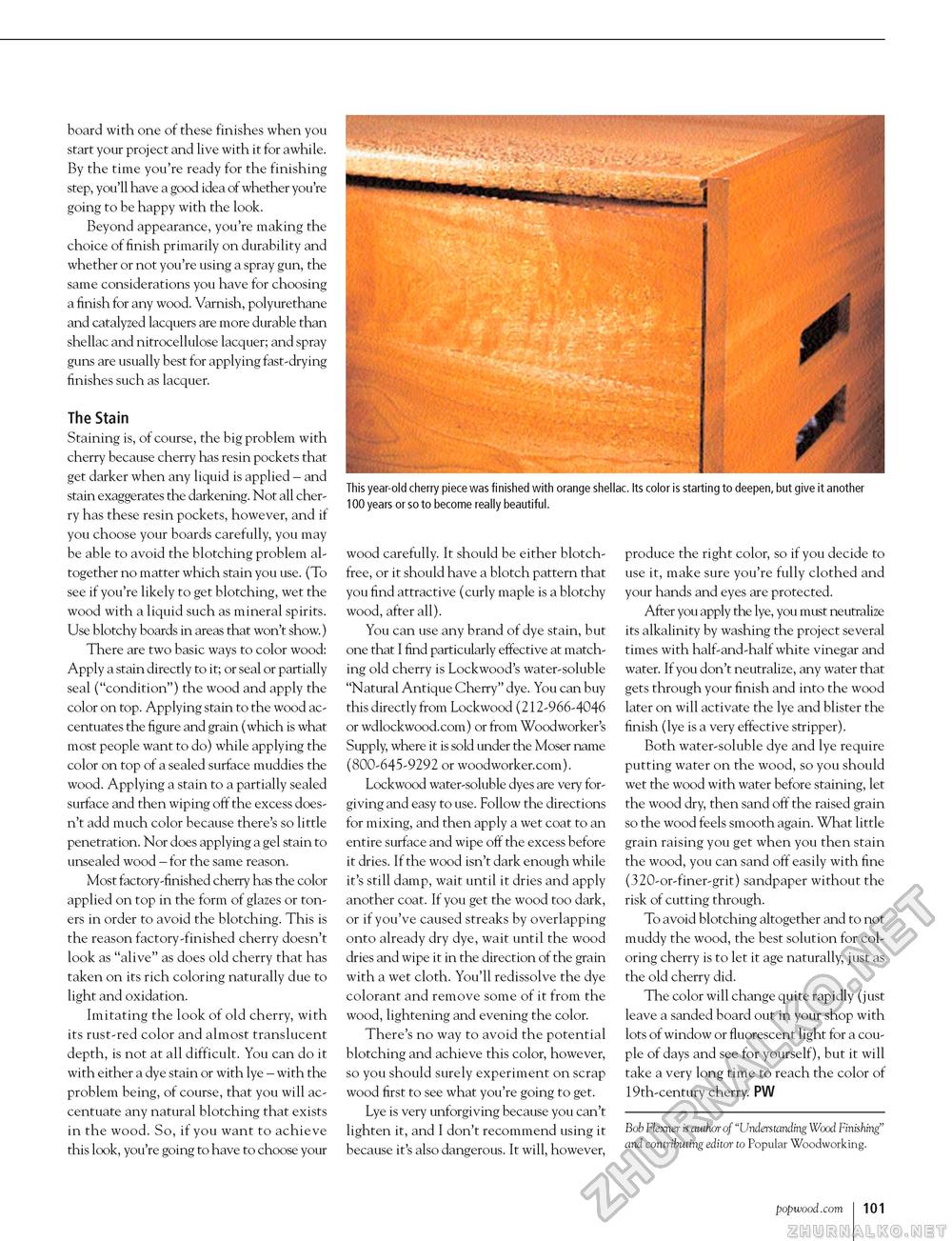Popular Woodworking 2003-02 № 132, страница 101
This year-old cherry piece was finished with orange shellac. Its color is starting to deepen, but give it another 100 years or so to become really beautiful. board with one of these finishes when you start your project and live with it for awhile. By the time you're ready for the finishing step, you'll have a good idea of whether you're going to be happy with the look. Beyond appearance, you're making the choice of finish primarily on durability and whether or not you're using a spray gun, the same considerations you have for choosing a finish for any wood. Varnish, polyurethane and catalyzed lacquers are more durable than shellac and nitrocellulose lacquer; and spray guns are usually best for applying fast-drying finishes such as lacquer. The Stain Staining is, of course, the big problem with cherry because cherry has resin pockets that get darker when any liquid is applied - and stain exaggerates the darkening. Not all cherry has these resin pockets, however, and if you choose your boards carefully, you may be able to avoid the blotching problem altogether no matter which stain you use. (To see if you're likely to get blotching, wet the wood with a liquid such as mineral spirits. Use blotchy boards in areas that won't show.) There are two basic ways to color wood: Apply a stain directly to it; or seal or partially seal ("condition") the wood and apply the color on top. Applying stain to the wood accentuates the figure and grain (which is what most people want to do) while applying the color on top of a sealed surface muddies the wood. Applying a stain to a partially sealed surface and then wiping off the excess doesn't add much color because there's so little penetration. Nor does applying a gel stain to unsealed wood - for the same reason. Most factory-finished cherry has the color applied on top in the form of glazes or toners in order to avoid the blotching. This is the reason factory-finished cherry doesn't look as "alive" as does old cherry that has taken on its rich coloring naturally due to light and oxidation. Imitating the look of old cherry, with its rust-red color and almost translucent depth, is not at all difficult. You can do it with either a dye stain or with lye - with the problem being, of course, that you will accentuate any natural blotching that exists in the wood. So, if you want to achieve this look, you're going to have to choose your wood carefully. It should be either blotch-free, or it should have a blotch pattern that you find attractive (curly maple is a blotchy wood, after all). You can use any brand of dye stain, but one that I find particularly effective at matching old cherry is Lockwood's water-soluble "Natural Antique Cherry" dye. You can buy this directly from Lockwood (212-966-4046 or wdlockwood.com) or from Woodworker's Supply, where it is sold under the Moser name (800-645-9292 or woodworker.com). Lockwood water-soluble dyes are very forgiving and easy to use. Follow the directions for mixing, and then apply a wet coat to an entire surface and wipe off the excess before it dries. If the wood isn't dark enough while it's still damp, wait until it dries and apply another coat. If you get the wood too dark, or if you've caused streaks by overlapping onto already dry dye, wait until the wood dries and wipe it in the direction of the grain with a wet cloth. You'll redissolve the dye colorant and remove some of it from the wood, lightening and evening the color. There's no way to avoid the potential blotching and achieve this color, however, so you should surely experiment on scrap wood first to see what you're going to get. Lye is very unforgiving because you can't lighten it, and I don't recommend using it because it's also dangerous. It will, however, produce the right color, so if you decide to use it, make sure you're fully clothed and your hands and eyes are protected. After you apply the lye, you must neutralize its alkalinity by washing the project several times with half-and-half white vinegar and water. If you don't neutralize, any water that gets through your finish and into the wood later on will activate the lye and blister the finish (lye is a very effective stripper). Both water-soluble dye and lye require putting water on the wood, so you should wet the wood with water before staining, let the wood dry, then sand off the raised grain so the wood feels smooth again. What little grain raising you get when you then stain the wood, you can sand off easily with fine (320-or-finer-grit) sandpaper without the risk of cutting through. To avoid blotching altogether and to not muddy the wood, the best solution for coloring cherry is to let it age naturally, just as the old cherry did. The color will change quite rapidly (just leave a sanded board out in your shop with lots of window or fluorescent light for a couple of days and see for yourself), but it will take a very long time to reach the color of 19th-century cherry. PW Bob Flexner is author of"Understanding Wood Finishing' and contributing editor to Popular Woodworking. popwood.com 101 |








